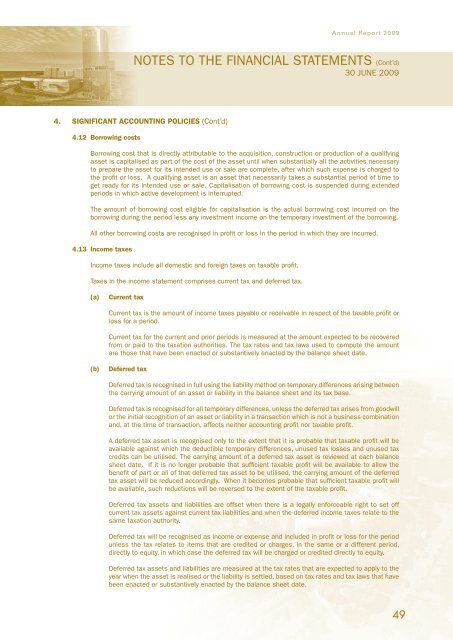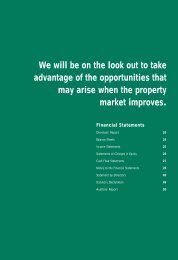2009 - Malaysia Pacific Corporation Berhad
2009 - Malaysia Pacific Corporation Berhad
2009 - Malaysia Pacific Corporation Berhad
Create successful ePaper yourself
Turn your PDF publications into a flip-book with our unique Google optimized e-Paper software.
Annual Report 20 09NOTES TO THE FINANCIAL STATEMENTS (Cont’d)30 JUNE <strong>2009</strong>4. SIGNIFICANT ACCOUNTING POLICIES (Cont’d)4.12 Borrowing costsBorrowing cost that is directly attributable to the acquisition, construction or production of a qualifyingasset is capitalised as part of the cost of the asset until when substantially all the activities necessaryto prepare the asset for its intended use or sale are complete, after which such expense is charged tothe profit or loss. A qualifying asset is an asset that necessarily takes a substantial period of time toget ready for its intended use or sale. Capitalisation of borrowing cost is suspended during extendedperiods in which active development is interrupted.The amount of borrowing cost eligible for capitalisation is the actual borrowing cost incurred on theborrowing during the period less any investment income on the temporary investment of the borrowing.All other borrowing costs are recognised in profit or loss in the period in which they are incurred.4.13 Income taxesIncome taxes include all domestic and foreign taxes on taxable profit.Taxes in the income statement comprises current tax and deferred tax.(a)Current taxCurrent tax is the amount of income taxes payable or receivable in respect of the taxable profit orloss for a period.Current tax for the current and prior periods is measured at the amount expected to be recoveredfrom or paid to the taxation authorities. The tax rates and tax laws used to compute the amountare those that have been enacted or substantively enacted by the balance sheet date.(b)Deferred taxDeferred tax is recognised in full using the liability method on temporary differences arising betweenthe carrying amount of an asset or liability in the balance sheet and its tax base.Deferred tax is recognised for all temporary differences, unless the deferred tax arises from goodwillor the initial recognition of an asset or liability in a transaction which is not a business combinationand, at the time of transaction, affects neither accounting profit nor taxable profit.A deferred tax asset is recognised only to the extent that it is probable that taxable profit will beavailable against which the deductible temporary differences, unused tax losses and unused taxcredits can be utilised. The carrying amount of a deferred tax asset is reviewed at each balancesheet date. If it is no longer probable that sufficient taxable profit will be available to allow thebenefit of part or all of that deferred tax asset to be utilised, the carrying amount of the deferredtax asset will be reduced accordingly. When it becomes probable that sufficient taxable profit willbe available, such reductions will be reversed to the extent of the taxable profit.Deferred tax assets and liabilities are offset when there is a legally enforceable right to set offcurrent tax assets against current tax liabilities and when the deferred income taxes relate to thesame taxation authority.Deferred tax will be recognised as income or expense and included in profit or loss for the periodunless the tax relates to items that are credited or charges, in the same or a different period,directly to equity, in which case the deferred tax will be charged or credited directly to equity.Deferred tax assets and liabilities are measured at the tax rates that are expected to apply to theyear when the asset is realised or the liability is settled, based on tax rates and tax laws that havebeen enacted or substantively enacted by the balance sheet date.49




